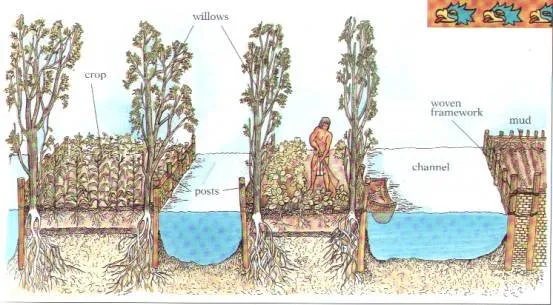New Revelations on the America Before Columbus

In this fascinating book, titled after the year before Columbus' voyage, Mann has compiled most recent data from such varying disciplines as botany, climatology, epidemiology, soil science, but also demographics and economics, that counter these outdated views, which are starkly reminiscent of what Thomas Hobbes called the noble savage.
The most important points Mann raises in 1491 have to do with the earliest settlement of the continent, the size of the population at the time of Columbus, the technological sophistication of the cultures living here, and the impact they had on their natural environment.
How Many People, How Long Ago?
These two questions seem to be the most interesting factors when assessing pre-columbian cultures. The most commonly held "general consensus" estimates the arrival over the Bering land bridge at around 13,000 years ago, leading to the rise of the Clovis culture. However, there seem to be cases of evidence indicating the presence of so called Paleo-Americans way into the Pleistocene, as far as 40,000 years ago. Similarly, the number of people present on this continent when Columbus first landed has been estimated between as low as 8 million to over 100 million people.
Throughout the book Mann cites research data supporting the notion of a higher population and longer settlement, which is interesting on its own. When looking at these numbers from the perspective of the carrying capacity of the environment, one can't help but wonder at the subsistence methods employed to feed a high population. This is where the book shifts from curious to captivating.
Techniques of Food Production
Some of the methods discussed in the book to grow large amounts of food I've been quite familiar with. One of my favorites, from living in Mexico City, are the chinampas I wrote about in a previous post. They are raised islands of organic matter in the shallow waters of Lake Texcoco, made using woven reed baskets around four trees, planted strategically in the water, and filled with essentially compost, where the food plants were planted into.

image source
What the book does not mention, though it has been another high density source of nutrients for the peoples living in this valley, is the harvesting of spirulina, which also grew naturally in the same lake. The fact that Mann omitted this "superest of superfoods" only goes to show that we are collectively just scratching the surface of knowledge, suggesting more credence to the high numbers.
But the Valley of Mexico is only one example of pre-columbian ingeniousness. Other cases deal with the impressive terraces in the South American Andes, the sophisticated forestry practices in Eastern North America, and the creation and cultivation of terra preta in the Amazon basin.
Growing Soil, Managing Species Diversity, and Modifying Ecosystems
With these, and numerous other examples, Mann gives us an idea how intensively - as well as extensively - pre-columbian americans maximized their food production, by harnessing natural systems and processes. Terra preta, for example, is a substance that would not occur naturally in the Amazonian rain-forest, where the majority of nutrients are found above the ground surface.
To add fertility to the relatively poor soil, its inhabitants grew a mix of charcoal, pottery shards, bones, manure, and compost using a microbial culture to convert it into abundant black soil. This seems like an elegant combination of re-using the wastes of their culture to increase the nutrients of the soil in order to grow food. Something we can certainly learn from.
Another amazing feat of increasing nature's abundance was the way native peoples managed the forests in North America. Far from letting them grow unchecked, they would use the trees in the most productive way, for food, forage, timber, firewood, etc. They would also control the forest by burning parts of it regularly, to diminish the chance of wildfires, minimize competition with the trees present, and give animals access to roam and forage. This is how the bison was able to migrate from the plains all the way to the Atlantic coast, and the forest encountered by first European settlers looked like "you could drive a carriage through it".
Humans as a Keystone Species
Without going into too much detail, I should mention that Mann's book also spends a great deal assessing the effects of European germs killing off most of the native population. Beside the obvious, such as deserted landscapes and abandoned settlements, it mentions the sudden explosion of species formerly controlled by humans, such as the passenger pigeon or the bison. At a later point in time, forests that were left unchecked also grew into thick densities, unable to provide the amount of food they used to.
Eye-Opening Facts
These pieces of data, woven together in a captivating narrative of a journalist by trade, make 1491 a book causing numerous a-ha moments, and ultimately creating a whole new image of the Americas before European contact. Of course, it's important to bear in mind that these theories are just that, but in the final analysis they may make a lot more sense than what we have been taught so far.
Join LBRY To Get Your Own Copies!
If you are interested in reading these books, you can find them on my stortebeker channel at LBRY. If you are interested in joining LBRY, please follow my invite. You may also be interested in my other book reviews in my Bibliophilia series:
My 12 Most Recommendable Permaculture Readings
Another 12 Permaculture Books - Specialized Readings
Riane Eisler – The Chalice and the Blade
William McDonough and Michael Braungart - Cradle to Cradle
Charles Eisenstein - Sacred Economics
Ken Kesey - One Flew Over the Cuckoo's Nest
Charles C. Mann - 1491
Tom Wolfe - From Bauhaus to Our House
Ideas and Concepts of Daniel Quinn
B. Traven - The Death Ship and The Cotton Pickers
Books by Wladimir Kaminer
Remembering the Good Doctor Gonzo - Hunter S. Thompson
Tom Wolfe - The Electric Kool-Aid Acid Test
Robert A. Wilson Expanding His Readers' Minds
Gary Jennings' Head-dive into Mexican History
Please check out these great communities I'm contributing to:

#ecotrain | What is EcoTrain | Discord Community

#cyclefeed | Introducing CycleFeed | Discord Community


Introducing SteemitDreamit | Discord Community